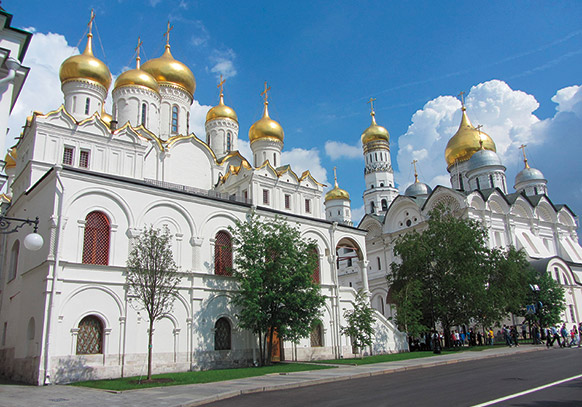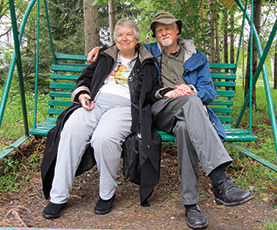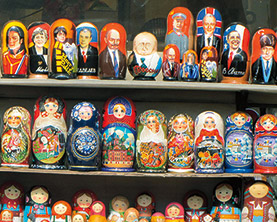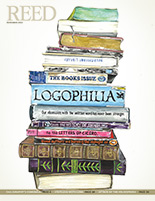
IRIS login | Reed College home Volume 91, No. 4: December 2012
Adventures in the First Person
Icons and Rollerblades

Kremlin cathedrals
A dispatch from the Reed Russian tour 2012.
By Brad Wright ’61


Brad and Rozelle perched on swing near the Tolstoy Estate; Matryoshka Dolls featuring Lenin, Obama, and Harry Potter.
It was totally unexpected.
We and other visitors were milling about the rear of the vast interior of the Kazan Orthodox church in St. Petersburg, admiring the magnificent walls—covered with holy images—and all that gold. Up at the front, a service was in progress. A priest was chanting. Except for some restless children, everyone was quiet. And then, high behind us, the choir exploded with a full-throated polyphonic response that reverberated wonderfully in that complicated space. So that’s what the walls are for—the icons, yes, but also the sound. And that’s why we visited Russia—to see, yes, but also to experience.
My wife Rozelle (class of ’61) and I were on this year’s Reed Russian tour, a program of the college’s Russian department organized and led by former Reed professor Judson Rosengrant [Russian 1979–90]. The itinerary, though anchored at Moscow and St. Petersburg, included side trips to Novgorod and to Tolstoy’s estate at Yasnaya Polyana. Joining us were other Reed alumni and friends.
For Rozelle, who plans all our trips, it was a new and exciting project. She tackled the reading list by listening to Tolstoy’s Anna Karenina on tape and diving into O. Figes’ Natasha’s Dance: A Cultural History of Russia for background on other Russian writers. We learned about the influential 20th century poet Anna Akhmatova, and became fans of Mikhail Bulgakov after reading his serious satire The Master and Margarita. A copy of G. Hosking’s Russia and the Russians: A History provided a fine background on geography, society, and politics.
The focus of the trip, however, was art and architecture—and it is hard to imagine two cities looming larger in this regard than Moscow and St. Petersburg. In Moscow, the Tretyakov Gallery features Russian art before the Soviet era, and the Pushkin Museum’s special collection of impressionist and post-impressionist paintings was especially rewarding and relaxing (with no other tour groups in sight). In St. Petersburg there was the Russian Museum at the Mikhailovsky Palace and, of course, the Hermitage complex. Rozelle and I had prepared for the latter by watching The Russian Ark, an incredible achievement in film production (it was recorded in a single take) in which the building itself is the principal character and the historical setting literally changes from room to room. So it was exciting to see the Hermitage in the flesh, as it were. Not to mention the thrill of walking right up to the works of Rembrandt, Matisse, Van Gogh, etc. At Jud’s suggestion we also explored the Hermitage’s remarkable collection of Roman portrait sculpture.
As with any group of Reedies, we all had different backgrounds and interests. In my case, I wanted to see how Russia had changed since my visit in 1975, when I represented Los Alamos National Laboratory’s program in (hot) fusion energy. In those days, technical exchange visits were part of confidence-building measures intended to ease the cold war. A later example was the Threshold Test Ban Treaty, which allowed the U.S. and the U.S.S.R. to verify, with onsite measurements, the energy release of each other’s underground nuclear explosions. Under that program, I served as a technical liaison to the Russian delegation that witnessed our JUNCTION shot at the Nevada Test Site. All of which gave me pause when I came to this question on the Russian visa application: “Do you have any specialized skills, training or experience related to fire-arms and explosives or to nuclear matters . . . ?”
Our group visited about a dozen Russian Orthodox churches that, though sharing the common Byzantine plan, presented unique architectural, historical, and artistic features. These ranged from the house-sized structure in the Peryn Cloister on Lake Ilmen near Novgorod to St. Petersburg’s truly impressive Church of the Savior on Blood, covered entirely with mosaics inside and out. In 1975, Russian churches were not on the must-see list. St. Basil’s near Red Square was sooty outside and off-limits inside. Indeed, given the realities of the mid-20th century, the churches and palaces we see today are mostly restored, reassembled, or completely reconstructed. For example, the monumental Church of Christ the Savior (of Pussy Riot fame) was originally constructed under Tsar Nicholas I but demolished by Stalin and ended up as a swimming pool. Not until 1990 was the church reconstructed in all its splendor. Especially appreciated, therefore, was our quiet visit to the Church of the Transfiguration (1374) in Novgorod. Its subdued, peaceful interior is adorned only by the remains of its original frescoes that, though muted, have not lost their power.
Nobody visits Russia merely to see artifacts, structures, and points of interest. They come to see Russia, and, so far as possible, the Russian people—the setting of the thing, as well as the thing. Indeed, in many instances, Tolstoy’s estate for example, the setting is the thing. So we looked out the windows: of the hotel, the plane, the bullet train, the hydrofoil, the Metro, the bus, and the taxi. From the walkway around St. Isaac’s dome, we felt that we were seeing all of St. Petersburg. From the hotel, looking across the low profile of the city, we could easily make out the incipient glow of the sun below the northern horizon at midnight. From the air, we became all too aware of the legendary, flat sameness of Russia’s landscape and the geographical isolation of its northern former capital.
But let’s not forget the sounds. Like the dawn chorus of birds waking us at 3:30 a.m. at Yasnaya Polyana. Or a low roar, a whirring, clickity-snickity noise mixed with a general murmur of unconstrained glee, the sound of thousands of young inline roller skaters cruising up Nevsky Prospect, completely shutting down midafternoon traffic in the heart of St. Petersburg. Yes, it was a city-sponsored event (something about honored citizens), but what fun!
Credit for a truly rewarding adventure belongs to our leader, Jud. Besides being a distinguished scholar and translator, he proved thoroughly invaluable and was engaged in all aspects of the trip, assuring that our individual needs were met in a way that interfered minimally with the activities of the group as a whole. It was through Jud’s help that Rozelle and I were able to visit, on our own, the shrines of our new-found writer heroes Akhmatova and Bulgakov. And it was thanks to his considerable experience that two serious passport emergencies affecting our group (a Metro pickpocket and a bumbling hotel clerk) were successfully resolved. It’s not that such incidents are common, but it’s good to have an uncommon person in charge.
Though we absorbed a lot of Russia in two weeks, we did miss one essential experience: the famous Russian winter. Jud says the view of the frozen Neva from the Fortress of Peter and Paul is quite peaceful in January. Paideia in St. Petersburg? Maybe not this time. But a postgraduation (think White Nights) trip is on the books for next spring. Check it out.


LATEST COMMENTS
steve-jobs-1976 I knew Steve Jobs when he was on the second floor of Quincy. (Fall...
Utnapishtim - 2 weeks ago
Prof. Mason Drukman [political science 1964–70] This is gold, pure gold. God bless, Prof. Drukman.
puredog - 1 month ago
virginia-davis-1965 Such a good friend & compatriot in the day of Satyricon...
czarchasm - 4 months ago
John Peara Baba 1990 John died of a broken heart from losing his mom and then his...
kodachrome - 7 months ago
Carol Sawyer 1962 Who wrote this obit? I'm writing something about Carol Sawyer...
MsLaurie Pepper - 8 months ago
William W. Wissman MAT 1969 ...and THREE sisters. Sabra, the oldest, Mary, the middle, and...
riclf - 10 months ago